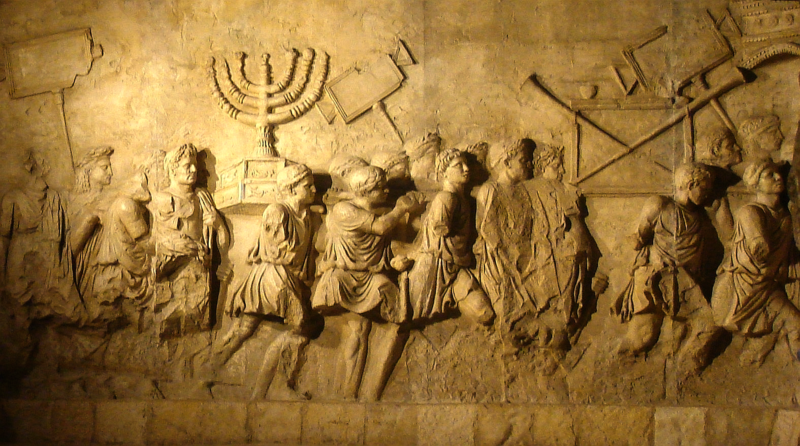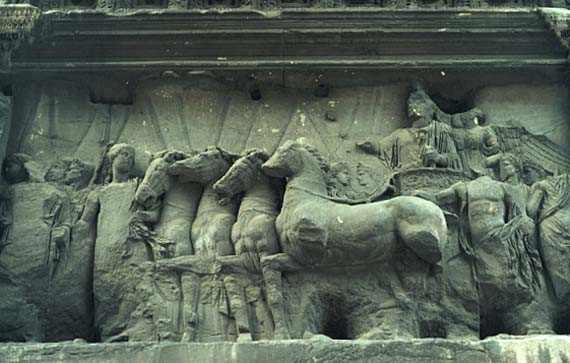Cards In This Set
| Front | Back |
|
The Republican Period
|
The Republic was founded in 509 B.C.E, but most of the works that have survived from that period date from about 200 BCE-27 BCE
|
 here |
Temple of Portunus, Rome, c. 80 B.C.E, stone
Italic style: stands on a podium and engaged lateral columns emphasize the frontal approach
-the Ionic columns have the slender proportions of Classical Greek temples as well as the white marble stucco, which deliberately evoked the translucent marbles used by Greek architects
-the practice of borrowing Greek forms began early in the Roman Republic
-was constructed by a Greek architect, Hermodorus
|
 Here |
Sanctuary of Fortuna Primigenia, early 1st century
-sanctuary to the goddess Fortuna Primigenia
-oracular center where priests interpreted divine will by drawing lots
-seven levels each with different purposes
|
 Here |
Augustus of Primaporta, 20 CE; ROMAN (The Early Empire)
Augustus was emperor during the Early Empire
-Roman portrait sculpture turned from the earlier veristic style of the Republic to a more classicizing style associated with ancient Greece
-until his death, portraits of Augustus depict him as an ageless youth
-both the contrapposto stance and the smooth features of his face are strongly reminiscent of Doryphoros from the Greek Classical Age
-shows the tendency in Roman art to express a message through references to earlier works (Cupid, dolphin, breastplate) - by associating Augustus with historical or divine figures, these references projected an image of earthly and divinely ordained power, thereby elevating the emperor above other politicians
|
 Here |
Scenes of Dionysiac Mystery Cult. Second style wall painting from the Villa of the Mysteries, Pompeii; 60-50 BCE; ROMAN
-second style painters sought to open up the flat expanse of the wall by including architectural features and figures - in this painting, parts of it are painted to resemble exotic stone -furthermore, figures interact as if on a narrow ledge set against a deep red background, articulated by upright strips of black resembling stylized columns
|
 Here |
Fourth Style wall painting, Ixion Room, House of the Vettii, Pompeii; 63-79 CE; ROMAN
fourth style painting = most intricate of the four, uniting aspects of all three preceding styles to create an extravagant effect
-combines imitation marble paneling, framed mythological scenes resembling panel pictures set into the wall, and fantastic architectural vistas receding into space
|
 Here |
Colosseum, Rome; 72-80 CE
-permanent amphitheater in Rome for the gladiatorial games
-every second opening was an entrance
-genius planning (especially in regards to getting people in and out)
|
 Here |
Arch of Titus, Rome, 81 CE; ROMAN
-stands at the far eastern end of the Roman Forum
-earliest surviving free-standing arch in Rome
-could have been a triumphal monument but it is more likely that it commemorates Titus' divinization after his death
-reliefs located inside the bay
|
 Here |
Relief in bay of Arch of Titus, showing procession of spoils from the Temple in Jerusalem, 81 CE; ROMAN
-the panel marks an important move toward illusionism in the portrayal of space - two ranks of figures appear, carved in different levels of relief; background figures seem to fade into the distance; seems to continue beyond a viewer's line of sight because the procession breaks away abruptly at the sides
-illusion of SPACIAL DEPTH
-panel even bulges out slightly in the center -- so that it seems to turn right in front of a viewer situated inside the arch's bay, making the viewer a part of the action
|
 Here |
Relief in bay of Arch of Titus, showing Titus riding in triumph, 81 CE?; ROMAN
-differing levels of relief
-horses appear in profile but chariot is frontal - giving the illusion that the procession is coming towards the viewer before turning sharply -- not realistic but artist wanted to show that there were 4 horses
-Vespasian's absence shows how Roman visual narratives are not always historically accurate depictions of events --> they are made to express a version of events that serves the patron's ideology
|
 Here |
Column of Trajan, Rome. 106-113 CE; ROMAN
-exploration of space and narrative
-there is a 656-foot continuous narrative relief that winds around the column -- celebrating the emperor's victorious campaigns against the Dacians
-combats rarely occur in the many scenes of the relief -- the geographic, logistic, and political aspects of the campaign receive more attention
-still part of the classicizing phase of Roman sculpture
|
|
Here
|
Portrait of Livia, 14 CE, marble
|
|
Here
|
Portrait of Vespasian, c. 75 CE
|
|
Here
|
Portrait of Domitia Longina, 90 C.E., marble
|



